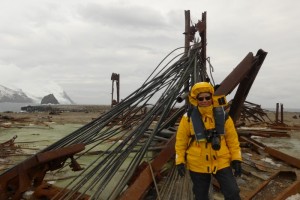Day 7 – 13 (March 30 – April 5): Thule
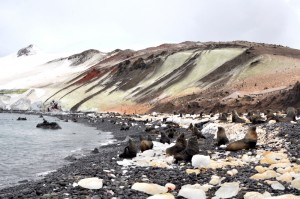 |
Day 7 (March 30, Monday): At sea – Noon GPS position 59° 37’ S / 040° 05’ W; Weather +1°C, overcast; Wind NE7; Sea 6; 1 lecture
Another ‘whale day‘. We are now sailing along the productive Scotia Plate parts of which reach 8,000m below sea level. This part of the ocean contains plenty of nutrients and food for krill and fish which are food for seabirds, whales and other marine mammals.
I am delighted to find the first light falling snow on this voyage and thrilled to watch sprouts from Humpback, Minke and Southern Right whales in all directions. I stay on deck and skip a lecture by Dmitri on ‘Adaption of Animals to Extreme Climatic Conditions‘ (I have already heard it once).
I enjoy Adam’s afternoon lecture on ‘Life and Death of Iceberg‘ and the recap with drinks and information on weather and what we have seen. Tonight’s documentary ‘Spy in a Huddle‘ is made using spy cameras to follow Emperor penguins in Antarctica, Rockhopper in the Falkland Islands and Humboldt in Peru. It is fascinating to watch how each species adapt and raises their chicks in difficult conditions (or extreme in the case of Emperor penguins). It is my dream to visit an Emperor penguin colony one day! (L-beef goulash; dinner-lamb)
Day 8 (March 31, Tuesday): At sea – Noon GPS position 59° 41’ S / 032° 13’ W; Weather 0°C, overcast; Wind NNE5/6; Sea 4/5; 2 lectures (GMT-2)
My third ‘Whale Day‘. The weather is not brilliant with an overcast sky. But it clears up later in the day. Despite the freezing temperature, I put on warm clothes and spend over 15 minutes walking in the helipad which is now empty (the helicopters for the Antarctica Odyssey voyage had returned to Chile). I have amazing view of sprouts popping up all over during exercise. How wonderful!
The best whale viewing session of the day is around lunch time. Lidia and I are still at the bridge when we spot a dozen of whales close to the bow. I take plenty of photos. Dmitri after looking at the images confirms they are Pilot long-fin whales.
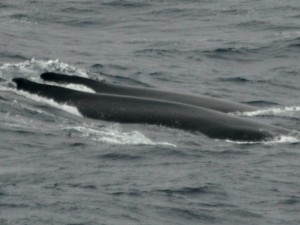 |
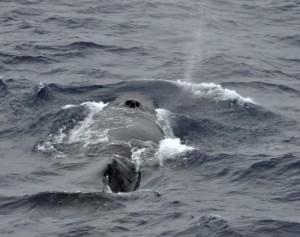 |
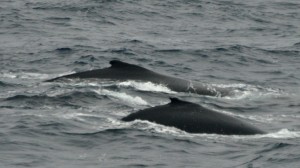 |
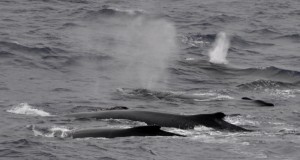 |
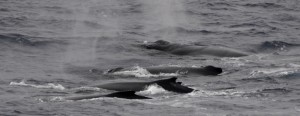 |
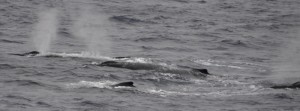 |
 |
 |
Brent continues with his lecture about his research findings on drastic fall of Adélie penguin population in the Antarctic Peninsula owing to a gradual loss of pack ice. He also has many encounters with Giant petrels and skuas and gives us tips on how to avoid attacks by these giant predators.
In the afternoon we have to go through Biosecurity procedures once again before landing in the British Overseas Territory of South Georgia and the South Sandwich Islands.
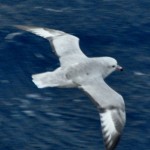 |
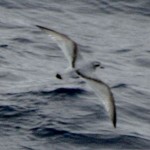 |
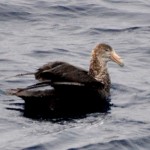 |
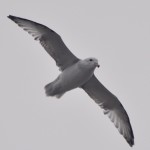 |
Victory gives an informative talk on history of exploration of the South Sandwich Islands.There are 11 islands in this group stretching between 56° – 59° S / 25° – 28°W in a north-south curve chain. During his second voyage (1772-75),CaptainCook discovered ‘Sandwich Land’ on January 31, 1775 and found eight islands. He concluded that “…it did not seem probable that anyone would ever be benefited by the discovery”. Bellingshausen discovered the remaining three islands in 1819. In 1938 Argentina claimed the islands and set up a refuge in 1955 in the Thule Island which has an area of 14 km²and a research base in 1977. During the Falkland War, the British bombed the station in June 1982 when ten scientists were in the station.
At the recap, Jan briefs us on the landing plan for South Thule Island. After dinner, I watch Part 2 of ‘Spy in the Huddle‘ when chicks arrive. They are fed and taken care of by their dotting parents. (L-noodles; dinner-roast beef)
Day 9 (April 1, Wednesday- April Fool Day): Thule Island, South Sandwich Islands – Noon GPS position 59° 31’ S / 027° 16’ W; Weather +2°C, overcast, good visibility; Wind N6; Sea 4; 4th Landing; 1000nm to Bouvetøya
Jan’s morning call wakes me and I am disappointed to hear that the ship is skipping the South Sandwich Islands owing to pack ice. Then he says cheerfully that it is a joke for April Fool Day!
In fact Ortelius is approaching the sheltered Ferguson Bay off the southern shores of the island. I get on deck and have a most amazing view of Hewison Point backed by steep slopes of snow and volcanic cliffs reaching high up into the clouds. The Cook Island which forms the other side of an ancient caldera lies east of the island. The ship drops anchor while we have breakfast.
Few visitors have come as this group of volcanic islands are far off the main Antarctic route. We are definitely the only group for this season. The first zodiac ferry begins at 8:30am. Most of the people have already gone when I step into the zodiac. The island is teeming with wildlife – properly 200,000 pairs of Adélei penguins, a small number of Gentoo penguins, tens of thousands of fur seals and many gigantic elephant seals.
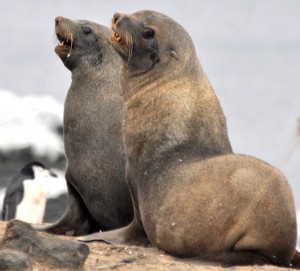 |
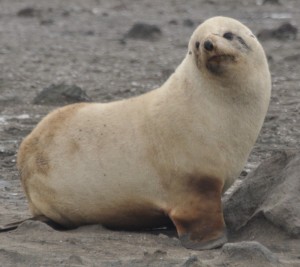 |
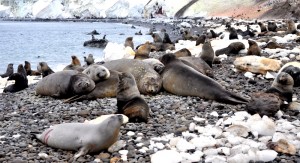 |
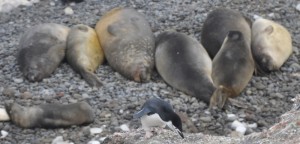 |
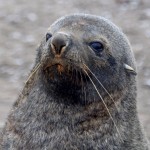 |
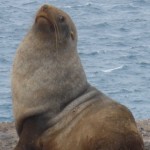 |
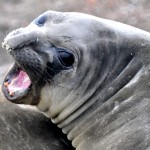 |
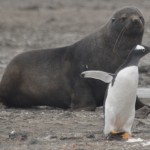 |
I spend two wonderful hours ashore. Our landing site is crowded with elephant seals, fur seals, penguins and birds. We have to climb a short but very steep slope to reach the undulating flat of Hewison Point. The view here is eerie but amazing with thousands of penguins, fur seals, gulls, skuas, derelict ruins – remnants of a recent war! For me this is the most memorable sight of this voyage. The ruined Argentinian field station is an eye-sore but the British administration has not shown any intention to clean up the mess. What a shame!
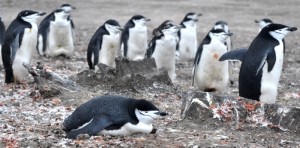 |
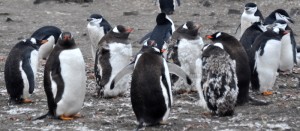 |
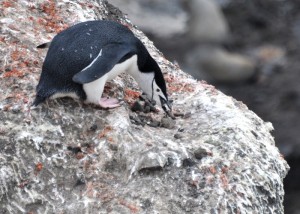 |
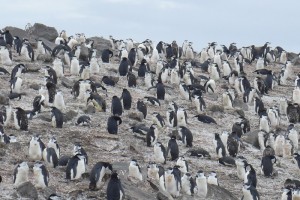 |
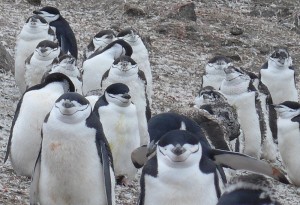 |
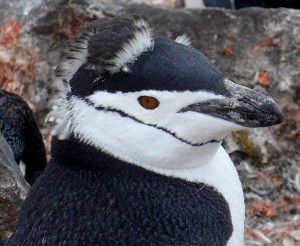 |
I stand still watching the funny-looking Chinstrap penguins running around picking up and dropping stones. Because of the long day with sunlight, these guys are disoriented thinking it is time for mating and nest-making. There are also several satellite groups of tired-looking moulting Gentoo penguins, many Southern Giant petrels, Kelp gulls and skuas.
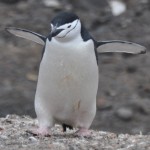 |
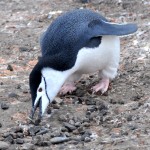 |
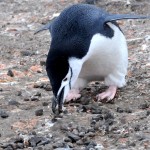 |
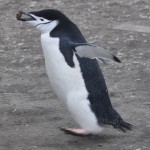 |
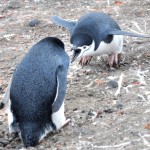 |
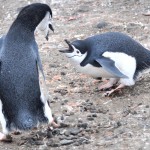 |
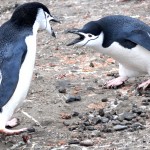 |
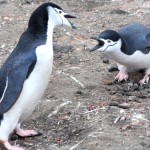 |
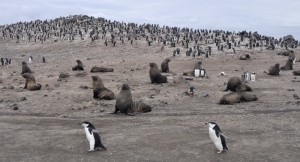 |
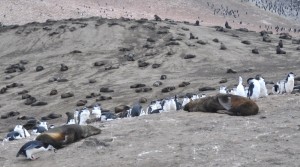 |
The ruined Argentinian field station is an eye-sore but the British administration has not shown any intention to clean up the mess. What a shame!
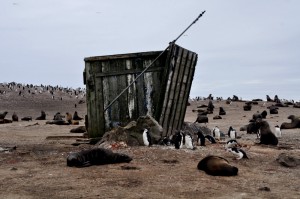 |
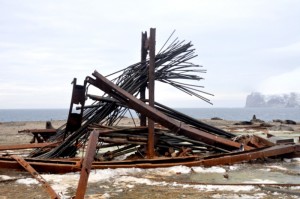 |
I learn that a Southern Right whale has come close to the ship but I miss it! Assistant Hotel Manager DJ gives me two cups of hot chocolate with rum as soon as I set foot on the ship. He is great always with a cheerful smile.

Once everyone is on board, Ortelius pulls up the anchor commencing our 1000nm-journey to Bouvetøya. The sea is calm and the temperature is above freezing. I stay on deck for several hours to look at Thule, Cook and Bellingshausen Islands, spot whales and enjoy the ambiance and serene and surreal Antarctic scenery. The weather has been extremely kind: we have four good landings.
In the afternoon, Jan gives a lecture on the ‘History of Whaling‘ – how the Dutch and English went north for whaling to get oil. When the stock of whales in the Arctic was depleted, whalers moved south especially upon discovery of the rich stock of whales around South Georgia. It is estimated some 2-3 million whales were slaughtered in the last century. A worldwide ban of whaling except for scientific purposes has been in force since 1980s. But some countries including Iceland, Norway and Japan and indigenous people of the Arctic continue to hunt whales for the meat.
In the final part of the ‘Spy in the Huddle‘, all chicks have grown up ready to take their first plunge into the sea. They spend the next few years at sea before returning to their native land to breed. It is magical how they find their way home to take up the challenge to breed and be a parent. (L-chicken a la king; D-duck breast)
Day 10 (April 2, Thursday): At sea – Noon GPS position 58° 16’ S / 019° 19’ W; Weather +1°C, overcast; Wind N6; Sea 5; 2 lectures
A dull day with an overcast sky. But the sun breaks through at times and we have good lights for bird and whale watching. We continue to be thrilled by whale sightings including a couple of breaching Humpback and Fin whales. A Blue whale suddenly appears right by the ship when I am at the lecture room. Lidia is lucky and gets some good shots with its characteristic bumpy skin. I miss a chance to see the biggest mammal on earth. What a pity!
We are excited to find Chinstrip penguins on isolated blue icebergs. I take some photos.
In the morning, Victory gives a good account on Shackleton’s Forgotten Men- the Ross Sea Party. I have heard a lot about the Endurance and Shackleton’s miraculous escape without loss of life. But it is the first time I learn about the men on Aurora, a supply ship with his men trying to lay depots for Shackleton and party at the Ross Sea end. This team had an equally dramatic experience. Three men sadly died while three men were not rescued from Hut Point, Ross Island till 1917.
After lunch, I watch a documentary ‘Encountered at the End of the World‘ on people working at the McMurdo Base. Apparently people who are crazy about travel and want to experience life in the continent congregate at the base. Footage of divers and scientists working under the frozen sea and the various research projects are most fascinating. I know little about science and can hardly understand the projects they are working on!
Then Bob gives a lecture ‘Leviathans: the Life of Whales’ on the life of toothed and baleen whales. The information is similar to those I have learnt during the last voyage. Good revision! In the evening, I watch ‘Paddington‘ – a fairy tale adventure of a bear from Peru in London. (L-teriyaki beef; D-seafood paella)
Day 11 (April 3, Friday): At sea – Noon GPS position 57° 04’ S / 012° 05’ W; Weather +2°C, overcast; Wind NNW6; Sea 5; 2 lectures (GMT-1)
Another dull day. I spend some time at the bridge and on deck looking for whales. But as we are travelling in less productive water, the wildlife is less impressive. The birders spot some prions and Kerguelen petrels.
This ship carries a group of the most and best travelled people whose main or only goal for this trip is to reach Bouvetøya and step ashore. I am curious about travel motivations and decide to conduct a survey on this special group of travellers. I have conducted similar projects in connection with my Masters’ degree on tourism in Australia thirteen years ago. This project would keep me busy while providing me a chance to talk with other passengers.
I draw up a questionnaire with eight questions and conduct a pilot survey on Cathy and Tao. Two more specific questions on Bouvetøya are added later. Interviews begins after the ship has reached it without landing owing to weather conditions.
Christian gives a talk on ‘Shackleton’s Forgotten Nimrod Expedition’ 1907 – 09. This was Shackleton’s only real scientific and geographical expedition which had brought back many new specimens, geological studies, magnetic and meteorological readings. His men also made the first ascent of Mount Erebus, discovered the South Magnetic Pole, published Aurora Australis, the first book ever printed on the Antarctic continent. Shackleton and two companions reached the farthest south ever, just 180km from the geographic pole itself. In many ways Shackleton opened the path for Scott, who would return and reach the pole following routes, means and methods tested during the Nimrod expedition.
After lunch, I watch a BBC documentary ‘The Secrets of Scott’s Hut‘. I know little about Scott who appears to be formal, rigid and aloof. He was considered a hero after his tragic death but later seen by some as a failed expedition leader. A visual tour of the Scott’s hut enables me to see its layout and atmosphere which are totally different from Shackleton’s hut at Cape Royds. To me, it appears as a quarter – office-cum-laboratory. The director of the documentary confesses he is a fan of Scott: he has succeeded in showing Scott as a man with humility and vision who was keen for scientific discovery. His passionate love letters to his wife and pictures taken by him during his quest of the Pole make him more human.
I have not been to Cape Evans as Don, the expedition leader considered the weather too bad for zodiac operation. (But looking at the wind and weather conditions, many of us disagreed and were frustrated for losing our only chance to visit this historic hut.) I wish Don had shown us this documentary which would to some extent satisfy our urge to see it.
I attend Dmitri’s lecture on ‘Antarctic Seals’, including eared and true seals (‘Otariidae’ and ‘Phocidae’ respectively). He talks about different aspects of their biology, ecology and behaviour. Passengers are eager to have updates on progress from Jan at the recap.
Tonight I watch ‘Big Eyes‘ a film based on a truth story of Margaret Keane, a painter famous for painting her subjects with big eyes and her struggle with her abusive husband. The ferocious sea and the constant ‘bang, bang, bang’ noises from the bow keep me awake. (L- cheese and biscuit; D-beef)
Day 12 (April 4, Saturday): At sea – Noon GPS position 55° 59’ S / 005° 43’ W; Weather +2°C, overcast; Wind NNW7/6; Sea 6; 2 lectures
I cannot sleep and get up shortly after 5am. I watch the waves some of which hit the window of the bridge at Level 7! Despite the dreadful wind and weather, I spot a few birds wheeling around. Unbelievable!
Many people do not turn up for breakfast – they are seasick. Bob’s lecture ‘Plankton – smallest creatures, biggest impact’ takes place in the bar instead of the windowless lecture room on Level 3. It suits me well: I can watch the sea and waves. Bob describes different groups of Phyto – and Zooplankton typical for Antarctic waters, and their role in the ecosystem of the Southern Ocean.
We have a served lunch as it is not safe to walk around with a full plate. After lunch I watch an interesting documentary about the life of an orca (killer whales) family in the waters around the sub- Antarctic Crozet Islands. Orcas are smart, inquisitive and iconic: it is amazing to see how they hunt seals and penguins as a group.
To prepare us for our next landing, Victoria gives an afternoon talk entitled ‘A History of Bouvetøya’. Apparently, Bouvetøya is the holy grail for travel club members. It was first discovered by a French, Jean-Baptiste-Charles Bouvet de Lozier on January 1, 1739; hence the name of the island.It was seen by Lindsley, Norris and finally mapped by a German expedition led by Chun in 1899. Norway which has been a whaling nation has claimed Bouvetøya from the British and now maintains a weather station on the island. Strange things have happened including the finding of a life boat in a lagoon in 1964 which disappeared two years later.
Bouvetøya is considered the most inaccessible uninhabited island on earth as it is 2,300km from South Africa and 1,600 from Antarctica. With an area of about 20km² (9.5 x 7 km), it is essentially covered by ice and surrounded by glaciers (93%). Nonetheless, it is teeming with wildlife with millions of birds and seals.
At the 6:30pm recap, Jan shows us the weather chart for the next few days. The strong winds have slowed the ship down and we would be arriving one day late i.e. on Monday. As the members of travel clubs are desperate to land in order to tick it off from their list, Jan reassures them he would try his best to land. But it all depends on the weather; even if the winds die down, the swell can prevent a safe landing. Based on data available, a narrow window for landing may be available on Monday.
The evening entertainment is a thriller ‘Ghost writer‘ directed by Polanski featuring Pierce Brason as an ex-Prime Minister of the UK and his entanglement with CIA. A good movie! Before going to bed, I change my clock by an hour bringing it to Greenwich meantime. (L-spaghetti; D-fish)
Day 13 (April 5, Sunday-Easter): At sea & Crossing Greenwich Meridian – Noon GPS position 54° 53’ S / 000° 33’ E; Weather +3°C, overcast (some sun); Wind WNW7; Sea 6; 1 lecture (GMT)
We have lost track of what day of the week it is. The hotel staff have kindly reminded us of Easter Sunday by laying beautiful, brightly-coloured egg napkins on our breakfast table with chocolate eggs.
Today, we also cross the Greenwich Meridian: suddenly our daily ‘south’ and ‘west’ co-ordinates have transformed themselves into ‘south’ and ‘east’. For the next few days, we shall remain east of Greenwich. After Bouvetøya, we shall sail back to the west again. A bit confusing!
The sea is calmer but with big swells. There is no whitecap and the sun breaks through thick clouds at the horizon. Around 8:30am, we are still about 130nm from Bouvetøya. I skip the morning lecture by Dmitri on origin of whales as I have heard before.
The afternoon documentary is about an expedition to Bouvetøya in 2012 on a small ship Hanse Explorer with 25 passengers. This ‘Expedition Pour le Futur’ (an expedition for the future) managed to land on the island, reached Olavtoppen, the island’s highest point (780m), where a time capsule was placed. I find the expedition more about a man’s obsession to visit the remotest island on earth and cannot see what it has to do for the future generation.
Bob’s afternoon lecture ‘Arctic: Antarctic; what’s the difference?’ is interesting and easy to follow especially as I have been to the Arctic three times and the Antarctic twice. He gives an overview of every aspect of polar regions, not only the mammals, flora and fauna, but also the geology and history.
I can sense the rising tension amongst the desperate passengers. At the recap session, we learn that we shall approach the island around 6am. Jan shows us the weather forecasts which expect strong wind for the next 24 hours and a video on the successful landing nine years ago. As there is no suitable landing site on the island and given the unpredictable wind and swell conditions, one must be able to move fast capable of getting in and out of the zodiac without problem. If the weather allows zodiac operation to go ahead, the first four zodiacs would take the fit passengers. Anyone requiring assistance and personal attention should go last.
Jan reminds people not to do anything silly in order to set foot on the island. Any accident can endanger their own as well as others’ life. In case medical assistance is required, the ship has no choice but to go to Cape Town which takes nine days! He reiterates the ‘dos and don’ts‘ on Bouvetøya. In any case, Jan and the Captain will assess the situation when approaching the island.
Tonight I skip the movie ‘The best, exotic Marigold Hotel’ as I have already seen it. The ship is rolling making so much noise that I cannot sleep. I spend two hours at the bridge and in the empty bar reading and only manage to doze off for two hours before the morning call. My first sleepless night on this voyage! (L-beef ragout; D-rack of lamb)


